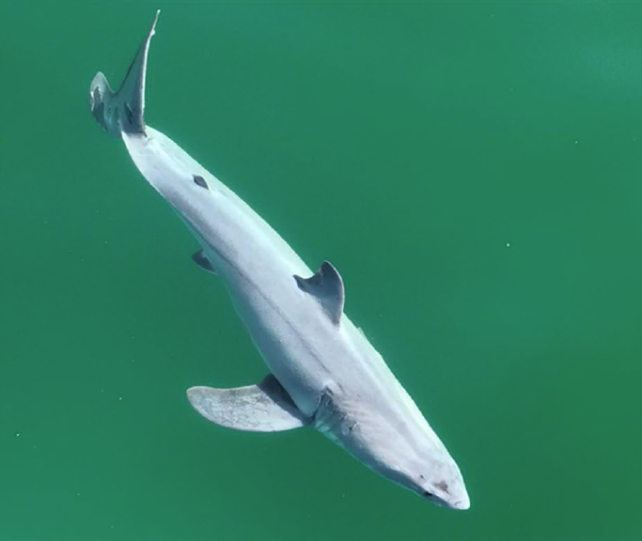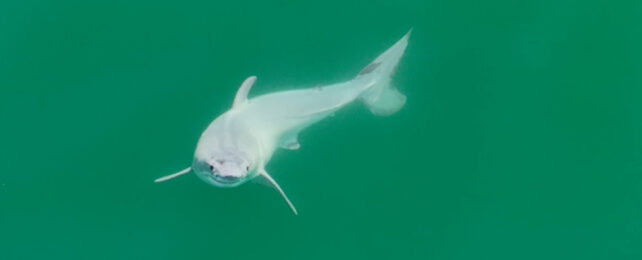A wildlife filmmaker and biology student have recorded something scientists have long been searching for: the first-ever glimpse of a newborn great white shark.
The young pup was spotted several hundred meters off the coast of Santa Barbara, California, in July last year in some mesmerizing drone footage captured by filmmaker Carlos Gauna.
With its two black eyes poking out above the ocean surface and its milk-white body below, it could be mistaken for a dugong or manatee. But its protruding snout, sleek body, and angular caudal fin cannot be confused for anything other than a white shark.
White sharks (Carcharodon carcharias), also known as great white sharks, are typically gray on top with a lighter, white underbelly. Pregnant females produce 'uterine milk', a yellowish and milky fluid for embryos to consume.
Guana had seen several seemingly pregnant sharks in the same area just days before the sighting. So the bright white shark immediately stood out to him when it surfaced.
"On this day, one of them dove down, and not long afterwards, this fully white shark appears," says Gauna, who goes by The Malibu Artist online. "It's not a stretch to deduce where the baby came from."
You can see the footage for yourself in the video below at around the 7:30 mark. The pregnant-looking mother shark disappears into darker waters, and in the next shot, a slim pale-white shark emerges from the glass-green sea.

The sighting has yet to be confirmed as a newborn white shark, although Gauna and coauthor Phillip Sternes, a shark biologist at the University of California Riverside, have published their findings in a peer-reviewed journal, describing how the pup might have been days or even hours old given its appearance.
What's more, the finding adds to earlier reports from 2020 of the smallest known white shark, just one meter long and thought to be a newborn, which was caught off the Pacific coast near the US-Mexico border.
"There are a lot of hypothetical areas, but despite intense interest in these sharks, no one's seen a birth or a newborn pup in the wild," says Sternes.
"This may well be the first evidence we have of a pup in the wild, making this a definitive birthing location."
It's not uncommon for the observations of budding naturalists or citizen scientists to find their way into the scientific literature. In fact, lucky sightings are a crucial part of scientific exploration and discovery that expands our understanding of the world.
In this case, the shark's diminutive size and rounded fins, resembling those of near-term shark embryos, suggest it was born not long before the drone came along. Gauna and Sternes also noticed that the whitish film sloughed off as the animal swam.
"I believe it was a newborn white shark shedding its embryonic layer," says Sternes.

There are other possible explanations we should consider, though. The shark could have an unknown skin disorder that results in the animal shedding skin, or be covered in some whitish microbial growth. It might also be a rare case of albinism.
But the timing of this shark surfacing not long after a pregnant-looking shark descended, and the patchy coloration on its pectoral fins, does seem compelling.
If the same individual can be spotted again, comparisons could be made to see how its skin has changed over time and how much it has grown. From their footage, Sternes and Gauna estimate the pup measured about 1.5 meters (4.9 feet) long, which is in the range of juvenile white sharks.
"Further research is needed to confirm these waters are indeed a great white breeding ground," Sternes says. "But if it does, we would want lawmakers to step in and protect these waters to help white sharks keep thriving."
The findings have been published in Environmental Biology of Fishes.
